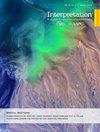Sparse Time-Frequency Analysis of Seismic Data via Convolutional Neural Network
IF 1.1
4区 地球科学
Q3 GEOCHEMISTRY & GEOPHYSICS
Interpretation-A Journal of Subsurface Characterization
Pub Date : 2023-09-04
DOI:10.1190/int-2023-0020.1
引用次数: 0
Abstract
Time-frequency (TF) analysis is commonly used to reveal the local properties of seismic signals, such as frequency and spectral contents varying with time/depth. Aiming to realize a highly localized TF representation of seismic signals, researchers treated the TF analysis as an inverse problem, and regularization was adopted in the objective functions. Traditionally, the TF sparse inversion process is solved by the Lasso regression. It has been proven that the Lasso regression needs a large number of iterations to reach a high accurate solution for the convex problem. Recently, convolutional neural networks (CNNs) have been successfully used to solve the convex problem due to their high computational efficiency and strong nonlinear characterization ability. We propose to solve the sparse TF inversion using CNN and our method is named STFA-CNN. The objective function in the neural network architecture consists of two portions. The first one is to minimize the difference between the local forward and backward Fourier transform of seismic signals. The second is minimizing the regularization l p norm of TF results. To demonstrate the effectiveness of our method, we apply it to both synthetic and real seismic data. We further use the TF results to compute the attenuation of seismic waveforms and apply the attenuation attribute to predict the hydrocarbons of a seismic survey acquired over the Ordos Basin, Northwest of China.基于卷积神经网络的地震资料稀疏时频分析
时频(TF)分析通常用于揭示地震信号的局部特性,如频率和频谱含量随时间/深度变化。为了实现地震信号的高度局部化TF表示,研究人员将TF分析视为一个反问题,并在目标函数中采用正则化。传统上,TF稀疏反演过程是通过Lasso回归来解决的。已经证明,Lasso回归需要大量的迭代才能达到凸问题的高精度解。最近,卷积神经网络(CNNs)由于其高计算效率和强大的非线性表征能力而被成功地用于解决凸问题。我们提出使用CNN来解决稀疏TF反演,我们的方法被命名为STFA-CNN。神经网络结构中的目标函数由两部分组成。第一个是最小化地震信号的局部前向傅立叶变换和后向傅立叶变换之间的差异。二是最小化TF结果的正则化lp范数。为了证明我们的方法的有效性,我们将其应用于合成和真实地震数据。我们进一步利用TF结果计算了地震波形的衰减,并将衰减属性应用于中国西北鄂尔多斯盆地地震勘探的碳氢化合物预测。
本文章由计算机程序翻译,如有差异,请以英文原文为准。
求助全文
约1分钟内获得全文
求助全文
来源期刊

Interpretation-A Journal of Subsurface Characterization
GEOCHEMISTRY & GEOPHYSICS-
CiteScore
2.50
自引率
8.30%
发文量
126
期刊介绍:
***Jointly published by the American Association of Petroleum Geologists (AAPG) and the Society of Exploration Geophysicists (SEG)***
Interpretation is a new, peer-reviewed journal for advancing the practice of subsurface interpretation.
 求助内容:
求助内容: 应助结果提醒方式:
应助结果提醒方式:


